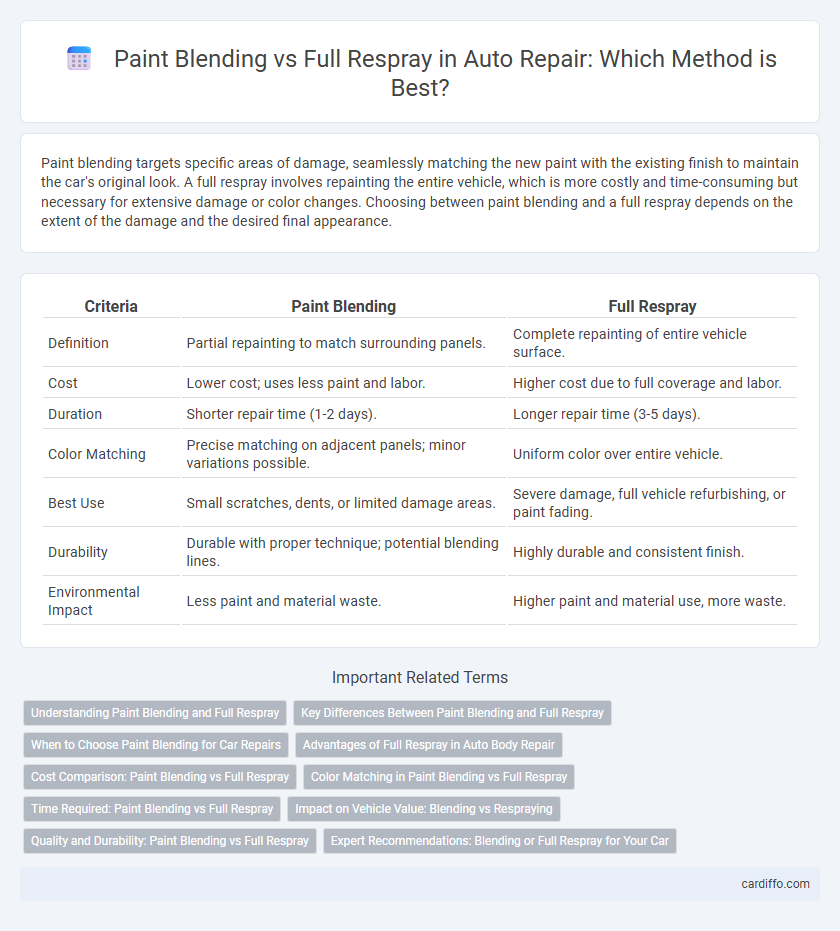Paint blending targets specific areas of damage, seamlessly matching the new paint with the existing finish to maintain the car's original look. A full respray involves repainting the entire vehicle, which is more costly and time-consuming but necessary for extensive damage or color changes. Choosing between paint blending and a full respray depends on the extent of the damage and the desired final appearance.
Table of Comparison
| Criteria | Paint Blending | Full Respray |
|---|---|---|
| Definition | Partial repainting to match surrounding panels. | Complete repainting of entire vehicle surface. |
| Cost | Lower cost; uses less paint and labor. | Higher cost due to full coverage and labor. |
| Duration | Shorter repair time (1-2 days). | Longer repair time (3-5 days). |
| Color Matching | Precise matching on adjacent panels; minor variations possible. | Uniform color over entire vehicle. |
| Best Use | Small scratches, dents, or limited damage areas. | Severe damage, full vehicle refurbishing, or paint fading. |
| Durability | Durable with proper technique; potential blending lines. | Highly durable and consistent finish. |
| Environmental Impact | Less paint and material waste. | Higher paint and material use, more waste. |
Understanding Paint Blending and Full Respray
Paint blending involves seamlessly merging new paint with existing panels to match color and finish, reducing costs and repair time compared to a full respray. A full respray requires repainting the entire vehicle or section to ensure uniformity, ideal for extensive damage or color changes. Understanding the differences helps in choosing the appropriate repair method based on damage severity, budget, and desired quality.
Key Differences Between Paint Blending and Full Respray
Paint blending involves seamlessly matching the new paint with the existing surrounding area, targeting specific damaged sections to restore color consistency without repainting the entire panel. A full respray requires completely repainting an entire vehicle or panel, ensuring uniform coverage but often at higher costs and longer repair times. Paint blending focuses on cost-effectiveness and minimal disruption, while full resprays prioritize comprehensive restoration and flawless finishes on entire surfaces.
When to Choose Paint Blending for Car Repairs
Paint blending is the preferred choice for minor scratches, dents, or color mismatches on localized sections of a vehicle, ensuring a seamless transition between new and existing paint. It preserves the original factory finish on large portions of the car, reducing overall repair costs and time compared to a full respray. Paint blending is ideal when the damaged area is small and adjacent panels have no significant damage, allowing for precise color matching and minimal impact on the vehicle's value.
Advantages of Full Respray in Auto Body Repair
Full respray in auto body repair ensures uniform color matching and restores the vehicle's original finish, eliminating imperfections that paint blending might miss. It provides long-lasting durability and protects the entire surface from rust and environmental damage. This method enhances overall aesthetics and increases the vehicle's resale value by delivering a flawlessly consistent appearance.
Cost Comparison: Paint Blending vs Full Respray
Paint blending typically costs 30% to 50% less than a full respray due to reduced labor and material usage, as it targets only the damaged panel area. A full respray involves sanding, priming, and painting the entire vehicle surface, significantly increasing both labor time and paint consumption. Choosing paint blending can save hundreds of dollars while maintaining color consistency when expertly applied.
Color Matching in Paint Blending vs Full Respray
Paint blending ensures precise color matching by seamlessly integrating the new paint with the existing finish, minimizing visible transitions and preserving the vehicle's original look. Full respray covers the entire panel, offering a uniform color application but may lead to slight shade variations due to differences in paint batches and fading over time. Advanced color matching technology and expert technician skills are critical in both methods to achieve optimal results and maintain the vehicle's aesthetic integrity.
Time Required: Paint Blending vs Full Respray
Paint blending typically requires less time than a full respray, often completing within a few hours by precisely matching and merging new paint with the existing finish. Full resprays demand significantly longer, generally taking several days due to the extensive preparation, masking, and multiple layered coats necessary to cover the entire vehicle. The time efficiency of paint blending reduces downtime for vehicle owners while maintaining a visually seamless repair.
Impact on Vehicle Value: Blending vs Respraying
Paint blending preserves more of the original factory finish, maintaining higher vehicle value by minimizing noticeable differences between repaired and unrepaired areas. Full respraying covers the entire panel or vehicle, potentially reducing value as it may signal major repairs to buyers or appraisers. Choosing blending over respraying helps retain resale value by offering a seamless, cost-effective cosmetic repair that aligns closely with the vehicle's original appearance.
Quality and Durability: Paint Blending vs Full Respray
Paint blending offers targeted color matching that preserves original panels, enhancing seamless repairs and reducing the risk of noticeable differences compared to adjacent areas. Full resprays provide a uniform finish across the entire vehicle, often resulting in superior durability and long-lasting protection against environmental factors. Choosing between paint blending and full respray depends on the extent of damage, with full resprays generally delivering higher overall quality for large-scale repairs.
Expert Recommendations: Blending or Full Respray for Your Car
Experts recommend paint blending for minor damage and to match existing paint seamlessly, preserving the original finish and saving costs. Full respray suits vehicles with extensive damage or widespread fading, ensuring uniform color and protection. Choosing the right method depends on the vehicle's condition, paint type, and budget considerations.
Paint blending vs full respray Infographic

 cardiffo.com
cardiffo.com